“You said you’d trust Ping. Why is Mulan any different?”
With a few arguable exceptions—The Jungle Book, Aladdin, and Pocahontas—Disney’s animated films had mostly focused on Western culture. Even those exceptions had been, shall we say, Americanized, especially in the case of The Jungle Book. By the mid-1990s, however, still caught up in the idea of doing serious, high art animation films, Disney decided to try something new: an animated film set in China. And, after some thought, they decided to hand over the idea to their Florida animation studio in Walt Disney World.
The Florida animation studio, opened in 1989, had been the brainchild not of animators, but of Disney executives searching for ideas for attractions for the third Walt Disney World theme park, then called Disney-MGM Studios. (As I type, it’s now called Hollywood Studios; the name is expected to be changed later this year as the park goes through another transformation.) Reasoning that theme park guests, to use the proper term, were eagerly buying up animation related merchandise, the executives figured that guests might also be interested in watching real animators at work, especially since—in the beginning—the entire park was intended to be not just a tourist attraction, but a working Hollywood studio. The theme park would include, then CEO Michael Eisner decided, not just Disney’s usual rides and shows, but working soundstages and a small animation studio.
A decade later, it became obvious that combining working soundstages with a Disney theme park in Florida was just not going to work. Eventually, Disney stopped making any real attempts to film there, transforming one soundstage into a Toy Story ride, and another into a little Disney museum that doubled as a tool to show trailers of upcoming Disney films. At the time, however, this was not at all clear to Michael Eisner, who insisted that the Florida animation studio be not just a tourist attraction, but a working studio where Disney park guests could watch animators work through one way glass, before leaving through a shop filled with animation art, including hand inked and painted cels, paintings, posters, and figurines.
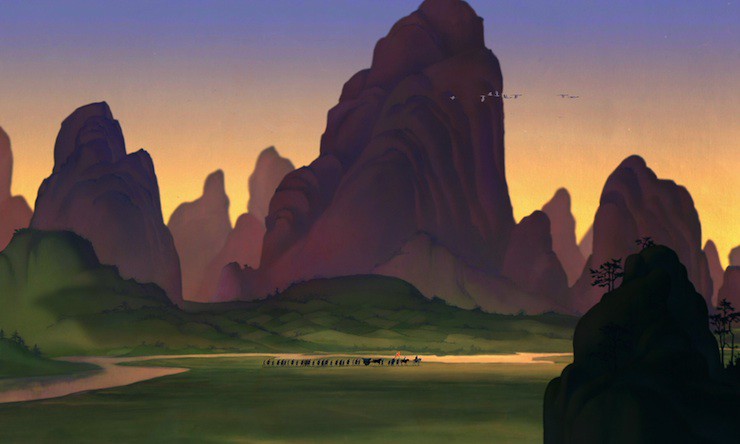
This was great for tourists (I had to be physically dragged away) but a little less great for animators, who now had to coordinate animation work on two different coastlines without the benefit of email or Skype. Adding to the stress, Disney executives—including Katzenberg—insisted that at least one bit from every upcoming movie be animated in the Florida studio in full view of guests, to help promote the films.
That is, guests who arrived during weekdays, when animation was actually happening; weekend guests typically only got to see the introductory film starring Walter Cronkite and Robin Williams and empty desks. Still, weekday guests got to watch animators create bits of Belle, Jasmine, little Simba, and Pocahontas. Some animators were fine with this, others less so. But from the point of view of Disney executives, the Animation area was a minor success during the 1990s, and eventually, the smaller studio was “rewarded” with the opportunity to do their very own film: Mulan.
Originally, Mulan was intended to be a romantic comedy, featuring misfit tomboy/crossdresser Mulan and the boy she’s betrothed to, but never met. In a startling change from decades of Disney animation, however, for once the animation department decided to go back to being more faithful to the source material, instead of less, and decided to bring the plot a little closer to the original ballad and some of the Chinese adaptations, and also make the design of the film look as authentic as possible, basing background paintings and (most) character designs on Chinese paintings. Some of the animators and designers also flew to China, to study local landscapes.
The end result is, granted, not all that faithful to the source material (and slightly wonky on Chinese geography), and ended up containing several distinctly American elements, including a Batman joke that is certainly not in the source material but which, I confess, I laughed at anyway. The accents, too, are all American, although the film made a credible attempt to mostly hire Asian-American actors before adding Eddie Murphy, Harvey Feinstein, Miriam Margoyles, and, for the final pop number played over the credits, Christina Aguilera. Basically, and to get this issue out of the way early, this is an American, not Chinese film, whatever the setting, possibly because the Americans sent over to China were allowed about three weeks to study and soak up Chinese culture—and that only included the artists lucky enough to go—but mostly because, well, this is an American film starring Americans made in Florida. But Mulan did abandon their original misfit proposal plot, returning to the story of a daughter who fights in her father’s place, for honor, getting at least that part right.
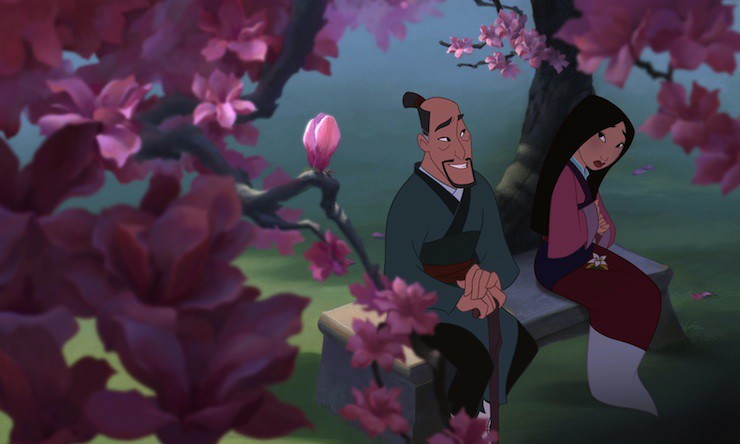
Unfortunately, some vestiges of that original treatment remain, creating some tonal dissonance within the film. For instance, the film starts off with a sequence where Mulan is carefully dressed and made up and brought to the matchmaker, to represent her family’s honor. It’s a nice callback to the original ballad, which focused on Mulan doing women’s work before heading out, dressed as a man, to fight in the army, and, after returning, putting her makeup back on, except for one problem. In the film, this sequence focuses on how clumsy and inept at everything Mulan is, and while that certainly does provide an additional reason for her to enter the military, and does make her eventual triumph in military training all that more triumphant, it also makes that triumph somehow a little less believable—especially because, according to the script, Mulan goes from clumsy girl to trained soldier within three weeks, which… ok then. (The Chinese stories either skip over the training period, or state that Mulan was trained by her father in martial arts.)
That tonal dissonance also returns at the end of the film, when, after Mulan has saved China and reconciled with her father, her grandmother keeps asking if Mulan is going to get a man, and the grandmother’s happy moment is when a man (Li Shang, who earlier rejected Mulan after finding out Mulan’s true gender) shows up. I suppose it works as a reminder that no matter what you do, some people will never change their hopes/wishes for you, and it’s certainly a reflection of what happens in real families, but within the film, to have a woman still squawk about Mulan’s potential husband after the girl saved the entire country feels, well, wrong. Especially since her father says no such thing. And while I don’t exactly want to read that much into this, the film tends to have men focused on matters that involve China’s safety and the honor of the entire family, while women are focused more on marriage.
In the end, however, Mulan is mostly a film about girl power. Girl power gained by dressing up as a boy, granted, but still, girl power. Disney had been churning out increasingly feminist Disney Princesses in recent years (and, as I’ve argued, Cinderella and Sleeping Beauty are probably a bit more feminist than they are given credit for), but even Ariel’s demands to choose her own pathway, Belle’s intellectualism and desire for her own life, Jasmine’s protest at a law that forces princesses into marriage, and whatever it is that Pocahontas is doing, never matched this: a girl who picks up sword and armor to save her father, and ends up saving China, first with a cannon and later with fireworks.
(Speaking of which, I am honestly trying not to read too much into a Disney film that just happens to suggest that fireworks can kill the bad guy and save a country just because the film just happened to be animated in a building located in a theme park that just happened to have at least two fireworks shows per night. Let’s all just pretend that the animators were inspired by their surroundings, and not trying to suggest that fireworks shows can actually save the world or anything.)

There’s another, somewhat less successful attempt at suggested girl power, when, as part of the attempt to take the Forbidden City back from the Huns, Mulan’s three sidekick soldiers and new friends Yao, Ling and Chien-Po all dress up in drag to climb up the columns and—briefly—trick the Hun soldiers into believing that they are just sweet, harmless women. The trick works. I can’t exactly call it empowering, but given that this happens shortly after Mulan was rejected and called a traitor for pretending to be a boy, this “hey, we can only win this if we pretend to be women” does feel a bit satisfying.
Also satisfying: the way Mulan manages, and mostly on her own, to disprove almost everyone’s doubts about her. (Almost everyone—she never does manage to persuade the matchmaker that she could be an eligible bride, partly because the matchmaker doesn’t return at the end of the film.) But she does manage to persuade the Emperor of China that she’s both a worthy soldier and a potential bride for Li Shang. And she impresses Yao, Ling, and Chien-Po so much that they turn from skeptical enemies to close friends willing to follow her leadership. And she even wins over Li Shang, not once, but twice: once as a boy, and later, as a girl.
That said, and this may well be just me, I would have liked to have seen just a touch more groveling from love interest Li Shang. Girl saved your life, dude, and stopped—well, ok, delayed—the oncoming Hun army, and five hours later, you’re kicking her out of the army. Sure, this is slightly more merciful than the apparent required punishment for gender concealment and treason—death—but abandoning her in the snow after a massive act of heroism? Way to show your gratitude there. Oh, sure, Li Shang feels terrible about this, and he has his own heroic moments, and Mulan likes him immediately (she even checks him out) but still, dude, grovel.
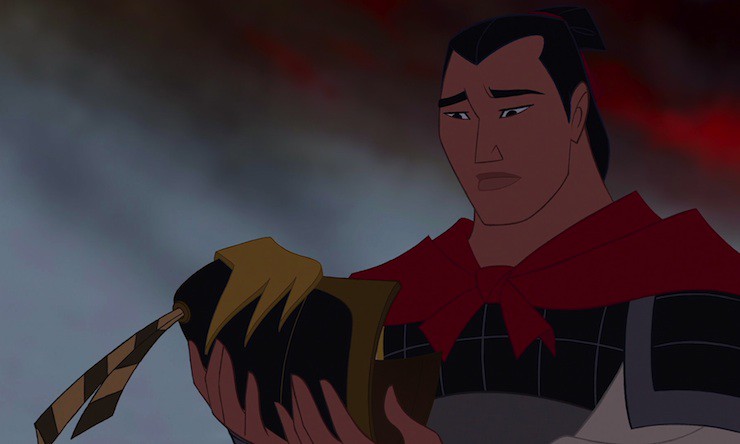
That said, in another excellent touch, Li Shang is more than a love interest; he has his own journey—not so much to accept Mulan for who she is, but to accept himself: a skilled warrior who has received his rank through nepotism. Or, at least, that’s what others conclude. Li Shang’s father dies during the film; his story ends not just interweaving with Mulan’s own focus on saving her father’s life, but her journey towards self-acceptance as well. They have quite a lot to bond them, even if Li Shang should be groveling more.
A less excellent touch: Mushu. Look, I love Eddie Murphy, and particularly loved his voicing of Donkey in Shrek, so it’s not Eddie Murphy, or Eddie Murphy’s voicing, or Eddie Murphy’s voicing a sidekick that’s the problem here. Or even the implication that Mushu firmly believes that Mulan can’t possibly succeed on her own and needs a man’s help—well, at least, a dragon’s help. As it turns out, Mushu isn’t even all that useful during Mulan’s training, though he tries, and less than useful in helping her seem like a man, although again, he tries. Mulan figures out how to get an arrow from the top of a flagpole on her own, without Mushu’s help, and she learns how to be a man by watching the men around her, again without Mushu’s help. I cheered, but I couldn’t help wondering why Mushu was even there.
As it turns out, Mushu does have a few useful moments: he helps light the cannon and the fireworks (though I also have to give credit to the cricket there), and, in his most effective scene, he comforts Mulan during her lowest moment, as he, Mulan, and the cricket all confess that they haven’t exactly been the world’s most honest people. And in a way, he’s there to mirror Mulan’s story: someone unhappy with his society’s perception of him and the role he’s supposed to play, desperate to prove himself—and help save someone else along the way.
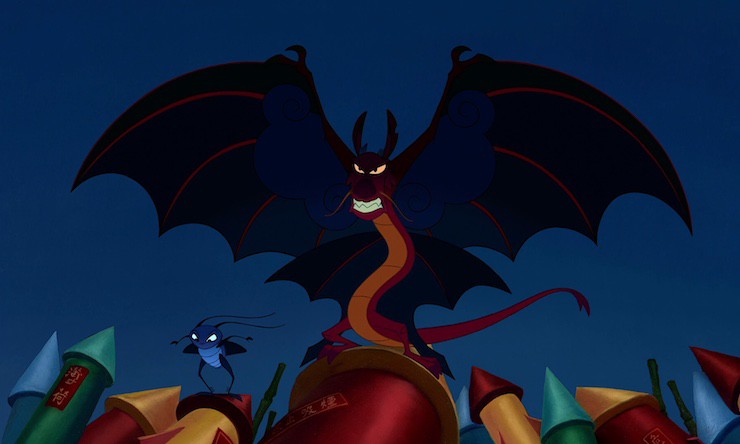
But Mushu wasn’t added to the film to mirror Mulan’s story. Rather, he was added to the film because, by the time Mulan was in development, the comedy sidekick, and in particular, the comedy sidekick voiced by a famous comedian, was a Disney requirement. To the point where Mushu was added to the film not because the animators wanted him, but because Roy E. Disney, at that point the head of Disney Animation demanded that he be added to the film.
And for that reason, perhaps, he doesn’t feel like an integrated part of the film, but rather like an addition—an irritating addition. The film has several other comedic characters—Mulan’s three sidekick soldiers and the cute little cricket—but Mushu dominates, because he’s Eddie Murphy, and he dominates with a number of anachronistic jokes. It’s a clear attempt to replicate the success of the Genie in Aladdin, not just in the celebrity comedian voicing, but in the use of deliberate anachronisms for comedic effect, and their role in the plot. Both characters are magical, both eager to help the protagonist in part to serve their own ends (Mushu is more selfish, ambitious, and hopeful in this than the Genie is), and both, of course, are helping protagonists keep up a web of deception. But, perhaps because he’s a replica, Mushu is never as funny as the Genie. He’s also, of course, nowhere as powerful, making him a bit more like a Jiminy Cricket—except for the problem that since Mushu is lying as much as Mulan is, he’s not exactly a great conscience, either.
It’s one of the fundamental problems with Mulan: too often, it feels as if the film is too tentative, too focused on replicating previous successes instead of embracing its strength: a strong story about a girl pretending to be a man to save her father’s life and her family’s honor, who just happens to fall in love along the way.
Unusually for a Disney animated film, Mulan also struggled with finding a composer and lyricist. The first person tapped was Stephen Schwartz, who wrote three songs for the film before Jeffrey Katzenberg approached him for help on a Dreamworks project. Schwartz agreed, infuriating Disney executives Peter Schneider and Michael Eisner, who still harbored sore feelings towards Katzenberg. They fired Schwartz, forcing the film to roll through several more composers until finally managing to hire long time film and television composer Jerry Goldsmith, probably best known to Tor.com readers as the man who scored Alien and several of the Star Trek films; he also won an Oscar for composing the music for The Omen, and several Emmys for his television work.
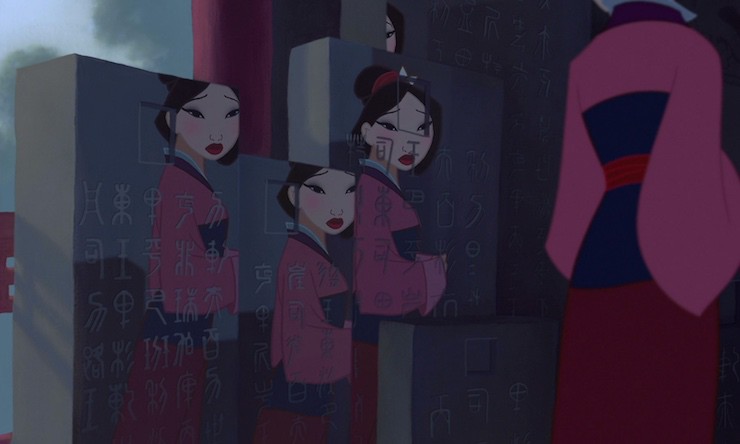
Somewhat hilariously, the final Mulan soundtrack was mostly remembered, in later years, for launching Christina Aguilera’s singing career. She’s not actually in the film, but her rendition of “Reflection” plays during the credits and became a minor pop hit, letting Aguilera continue on to bigger and better things. Hilarious not just because of the extensive time spent looking for a composer only to have that score mostly to have the score forgotten, but also because “Reflection” may be the weakest song in the film, falling short of “I’ll Make a Man Out Of You” and “A Girl Worth Fighting For.”
At a $302 million worldwide gross, Mulan’s box office performance was respectable—better than the previous two Disney releases, Hunchback of Notre Dame and Hercules. More ominously for Disney, however, the box office take came behind Pixar’s A Bug’s Life. The respectable box office performance was, however, enough to greenlight a genuinely terrible sequel, even by the not very high standards of Disney animated sequels, Mulan II, which I can only urge you to avoid if you want to keep your brain cells intact.
Mulan‘s greater financial impact, however, came a few years later, when Mulan was added to the Disney Princess line, even though, well, she’s not a princess, Shang isn’t a prince, and they don’t end the film married or even engaged (they’ve barely agreed to have dinner). Mulan wasn’t quite the only Disney Princess to end her film without a wedding—Pocahontas, after all, didn’t end her film married or engaged either, and the two would later be joined by Merida, a Pixar import. But other than Tinker Bell, who was soon moved to her own Disney Fairies Franchise, Mulan was and is the only Disney Princess with no real claim to a “princess” title.
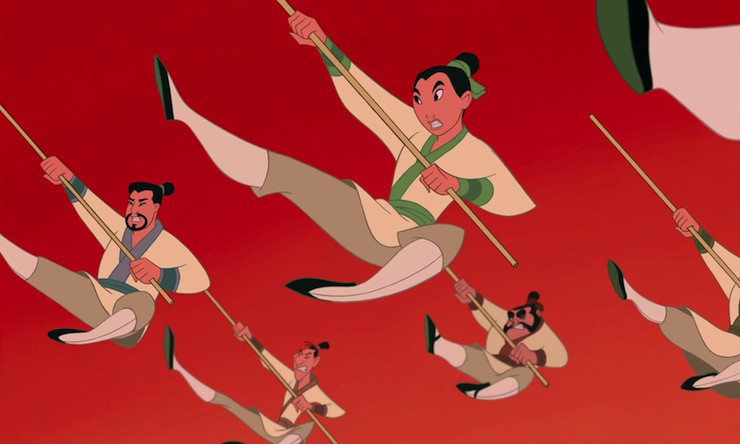
It’s an aspect that the current Disney Princess franchise has chosen to highlight, giving Mulan a “Find Your Inner Warrior” tagline over the current overall Disney Princess theme:
It’s time to dream of a world where a princess isn’t defined by her title. Or her tiara. Or even a pair of glass slippers. In this world, a princess is someone who inspires a new generation of girls to have the courage to make their dreams real.
This is all very nice, if just slightly undercut by the fact that right below this, Disney is selling not one, but two Mulan tiaras—a cute one for kids, and a considerably pricier one presumably for adults, or very indulged kids, by Arribas Brothers. In Disney’s defense, the tiaras are available for all Disney princesses, appearing below the same statement on all of their pages, and Mulan’s kiddie tiara is absolutely adorable and is purple AND gold and matches the equally adorable little Mulan costume. (The matching Mulan shoes are extra and, incomprehensibly, are not available for adults, like, SOME OF US WANT DISNEY PRINCESS SHOES TOO, Disney!)
Tiaras aside, Mulan is the only Disney Princess depicted with a weapon on the main Disney Princess webpage—even Merida’s picture just shows her staring determinedly off into space. Snow White and Jasmine hold birds; Aurora has a basket, and the other princesses don’t seem to be holding anything. Mulan is also the only Disney Princess given a tagline associated with violence, with her “Find Your Inner Warrior” in direct contrast to the other taglines of “Always wonder,” (Aurora), “Be a Friend to All” (Snow White), “Make a Dream Real” (Tiana), “Don’t Judge a Book by its Cover” (Belle), “Explore New Worlds” (Ariel), “See the Good in Others” (Jasmine—and, er, what?), “Respect the Earth” (Pocahontas), “Never Give Up” (Cinderella) and even “Be Brave” (Merida). This probably says more about the Disney Princess line, and the lack of Asian characters in general in Disney animated films, but it still highlights just how much Mulan stands out from her fellow Disney Princesses. Which is undoubtedly a good thing.
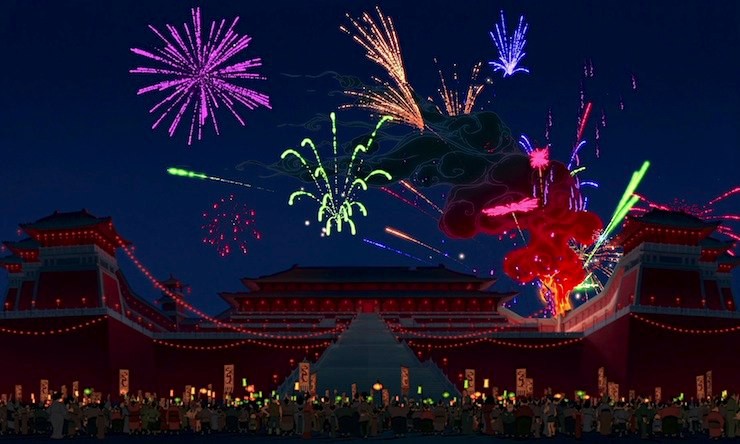
If Mulan did not exactly become a major hit, it still counted as a success for the Florida Animation Studio even before the launch of the Disney Princess line, proving that the animators there could be more than a tourist attraction. Having passed this test, the Florida Animation Studio went on to create Lilo and Stitch and Brother Bear, before getting reduced once again to a walk through tourist attraction in 2004. The attraction didn’t completely forget animation: guests could watch artists patiently hand ink cel art, or take a twenty minute class on how to draw a Disney character, but for the most part, it was a character meet and greet area, used by many in the summer to escape the Florida heat. In July 2015, Disney closed the attraction completely. The building reopened as a Star Wars exhibit in December 2015, featuring original Star Wars props, video games, and character meet and greets. The Disney Animation Art store was transformed into a third Star Wars store at the Hollywood Studios theme park.
By then, Disney animators were back at the California studio.
Next up: Tarzan.
Mari Ness lives in central Florida.










